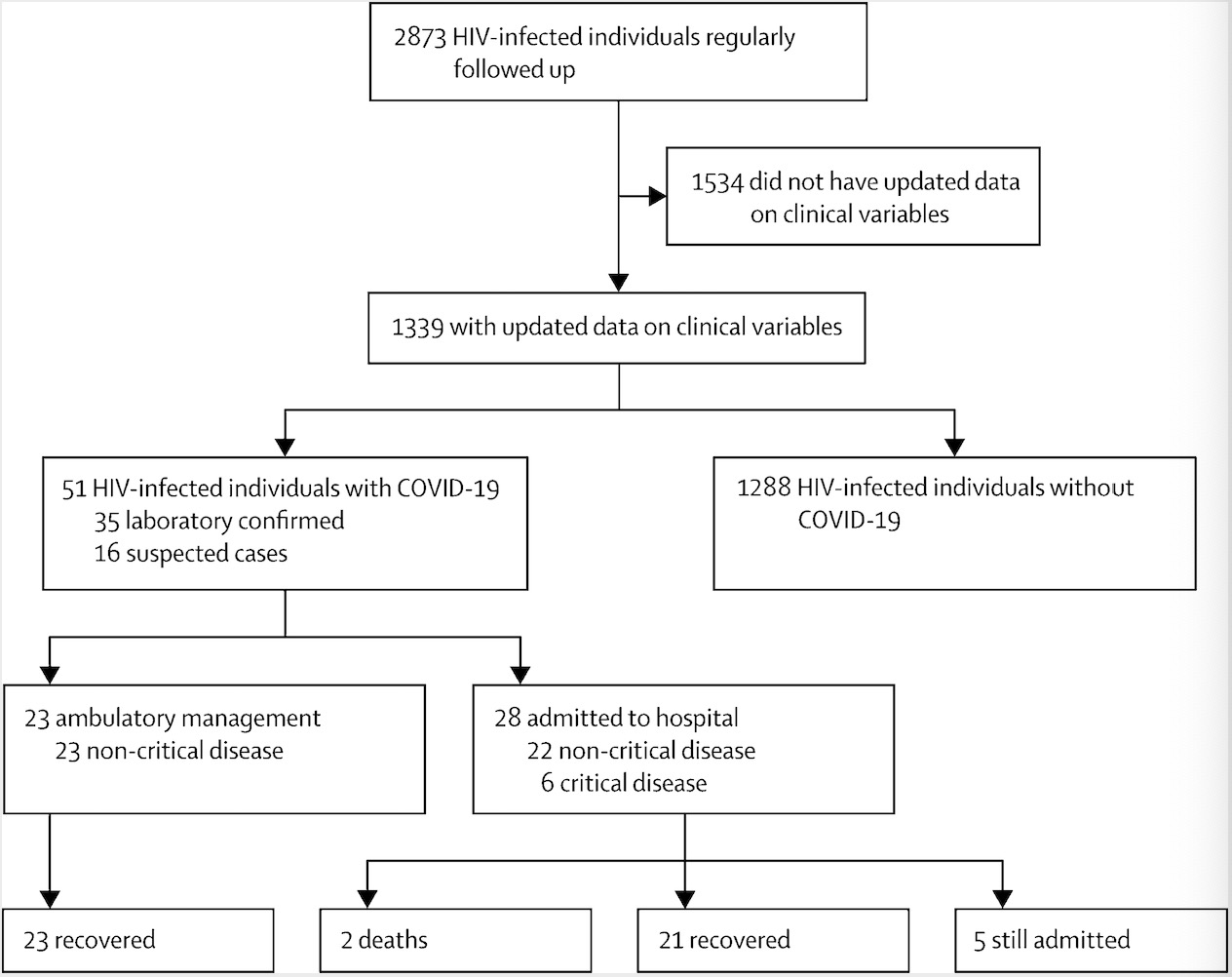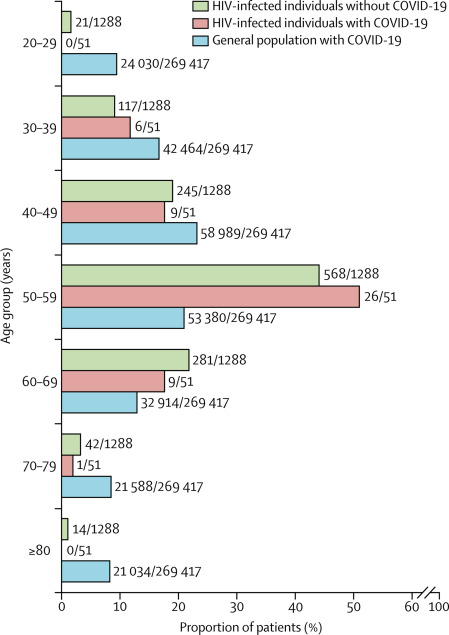HIV (Human Immunodeficiency Virus) infected persons may be at increased risk when facing SARS-CoV-2 or severe disease, especially those with comorbidities, low CD4 cell counts or uninhibited HIV RNA viral load , The risk is particularly great.
However, HIV patients usually take immunosuppression or regularly use antiretroviral drugs, such as protease inhibitors, nucleoside reverse transfer inhibitors or Non-nucleoside reverse transfer inhibitors (NNRTI) may change the risk of SARS-CoV-2 infection and clinical manifestations in this population . For this issue, the scientific research team from Spain provided detailed data describing the new crown infection rate of HIV-infected persons and the clinical features of the new crown of HIV-infected persons.
On May 28th local time, the international authoritative academic journal “The Lancet HIV” published from the universities of Ramon and Cahal in Spain A paper from the Hospital (Hospital Universitario Ramón y Cajal) “Description of COVID-19 in HIV-infected individuals: a single-centre, prospective cohort”.
Researchers have found that people with HIV should not be considered as immune to SARS-CoV-2 infection or have a lower risk of serious illness. And people with HIV should receive the same treatment as the general population.
 Currently, there is little information on the incidence, clinical features, and outcomes of new coronary pneumonia in HIV-infected people. The researchers found adult patients who were also infected with the new coronavirus among a group of HIV carriers in Madrid, Spain.
Currently, there is little information on the incidence, clinical features, and outcomes of new coronary pneumonia in HIV-infected people. The researchers found adult patients who were also infected with the new coronavirus among a group of HIV carriers in Madrid, Spain.
 Currently, there is little information on the incidence, clinical features, and outcomes of new coronary pneumonia in HIV-infected people. The researchers found adult patients who were also infected with the new coronavirus among a group of HIV carriers in Madrid, Spain.
Currently, there is little information on the incidence, clinical features, and outcomes of new coronary pneumonia in HIV-infected people. The researchers found adult patients who were also infected with the new coronavirus among a group of HIV carriers in Madrid, Spain.
In this study, the researchers included patients with suspected or diagnosed new crowns (age ≥18 years) as of April 30, 2020, They all come from the Larimon Cahal University Hospital in Madrid, Spain. The hospital has 1,100 beds, 2873 adult HIV patients, they are regularly followed up in HIV clinics.
 The researchers compared the characteristics of HIV-infected persons diagnosed with COVID-19 with samples of HIV-infected persons evaluated before the New Crown Pandemic and described the outcome of HIV-infected persons diagnosed with COVID-19.
The researchers compared the characteristics of HIV-infected persons diagnosed with COVID-19 with samples of HIV-infected persons evaluated before the New Crown Pandemic and described the outcome of HIV-infected persons diagnosed with COVID-19.
 The researchers compared the characteristics of HIV-infected persons diagnosed with COVID-19 with samples of HIV-infected persons evaluated before the New Crown Pandemic and described the outcome of HIV-infected persons diagnosed with COVID-19.
The researchers compared the characteristics of HIV-infected persons diagnosed with COVID-19 with samples of HIV-infected persons evaluated before the New Crown Pandemic and described the outcome of HIV-infected persons diagnosed with COVID-19.
COVID-19 was diagnosed in 51 HIV-infected people (incidence rate 1.8%, 95% CI 1.3% -2.3%). The average age of the patients was 53.3 years (SD9.5); 8 of them were women (16%) and 43 were men (84%). Thirty-five patients (69%) had co-infection and were diagnosed with new coronary pneumonia, and 28 patients (55%) required hospitalization.
 The age and CD4 cell count of 51 HIV-infected patients diagnosed with new crowns were similar to 1288 HIV patients who were not diagnosed with COVID-19; ) There is at least one comorbidity (mainly hypertension and diabetes), and 495 people (38%) with undiagnosed COVID-19 have at least one comorbidity. 37 patients (73%) who were diagnosed with new crowns used tenofovir before diagnosis, and 38% (487 patients) of patients who did not diagnose COVID-19 used tenofovir; (22%) had previously used protease inhibitors (mainly darunavir), and 14% (175 people) of the undiagnosed COVID-19 group used protease inhibitors. The clinical, analytical, and radiological performance of COVID-19 in HIV-infected patients is similar to that of the general population. Six people (12%) were critically ill, 2 people had a CD4 count of less than 200 cells per microliter, and 2 people (4%) died.
The age and CD4 cell count of 51 HIV-infected patients diagnosed with new crowns were similar to 1288 HIV patients who were not diagnosed with COVID-19; ) There is at least one comorbidity (mainly hypertension and diabetes), and 495 people (38%) with undiagnosed COVID-19 have at least one comorbidity. 37 patients (73%) who were diagnosed with new crowns used tenofovir before diagnosis, and 38% (487 patients) of patients who did not diagnose COVID-19 used tenofovir; (22%) had previously used protease inhibitors (mainly darunavir), and 14% (175 people) of the undiagnosed COVID-19 group used protease inhibitors. The clinical, analytical, and radiological performance of COVID-19 in HIV-infected patients is similar to that of the general population. Six people (12%) were critically ill, 2 people had a CD4 count of less than 200 cells per microliter, and 2 people (4%) died.
 6 patients (32%) had a median SARS-CoV-2 nucleic acid test positive duration of 40 days after the onset of symptoms, of which 4 patients had severe disease or low CD4 cell count.
6 patients (32%) had a median SARS-CoV-2 nucleic acid test positive duration of 40 days after the onset of symptoms, of which 4 patients had severe disease or low CD4 cell count.
 The age and CD4 cell count of 51 HIV-infected patients diagnosed with new crowns were similar to 1288 HIV patients who were not diagnosed with COVID-19; ) There is at least one comorbidity (mainly hypertension and diabetes), and 495 people (38%) with undiagnosed COVID-19 have at least one comorbidity. 37 patients (73%) who were diagnosed with new crowns used tenofovir before diagnosis, and 38% (487 patients) of patients who did not diagnose COVID-19 used tenofovir; (22%) had previously used protease inhibitors (mainly darunavir), and 14% (175 people) of the undiagnosed COVID-19 group used protease inhibitors. The clinical, analytical, and radiological performance of COVID-19 in HIV-infected patients is similar to that of the general population. Six people (12%) were critically ill, 2 people had a CD4 count of less than 200 cells per microliter, and 2 people (4%) died.
The age and CD4 cell count of 51 HIV-infected patients diagnosed with new crowns were similar to 1288 HIV patients who were not diagnosed with COVID-19; ) There is at least one comorbidity (mainly hypertension and diabetes), and 495 people (38%) with undiagnosed COVID-19 have at least one comorbidity. 37 patients (73%) who were diagnosed with new crowns used tenofovir before diagnosis, and 38% (487 patients) of patients who did not diagnose COVID-19 used tenofovir; (22%) had previously used protease inhibitors (mainly darunavir), and 14% (175 people) of the undiagnosed COVID-19 group used protease inhibitors. The clinical, analytical, and radiological performance of COVID-19 in HIV-infected patients is similar to that of the general population. Six people (12%) were critically ill, 2 people had a CD4 count of less than 200 cells per microliter, and 2 people (4%) died.
 6 patients (32%) had a median SARS-CoV-2 nucleic acid test positive duration of 40 days after the onset of symptoms, of which 4 patients had severe disease or low CD4 cell count.
6 patients (32%) had a median SARS-CoV-2 nucleic acid test positive duration of 40 days after the onset of symptoms, of which 4 patients had severe disease or low CD4 cell count.
Previous studies have shown that immunosuppression and low CD4 cell counts may protect HIV-infected people from the cytokine storms experienced by patients with new coronary severe disease. However, after adjusting for baseline characteristics, the researchers did not It was found that there is an association between the lowest CD4 cell count of HIV-infected people and the new crown.
Despite this, a lower CD4 cell count is associated with factors related to the severity of the disease, For example, a lower lymphocyte or platelet count and a higher level of interleukin 6. In addition, the researchers found that the CD4 count of people with HIV infection in the new crown is significantly lower than that of non-severe HIV infection in the new crown, although the difference is not significant. Two of the six people receiving ICU treatment had a CD4 cell count of less than 200 cells / microliter.
Therefore, the researchers believe that these data clarify the role of immunosuppression in The role of COVID-19 and suggest that in SARS-CoV-2 infection, HIV-infected individuals with low CD4 cell counts have a higher risk of complications, despite the small cohort size.
 Researchers said that in clinical terms, the description of COVID-19 is similar to that of other general populations in terms of symptom onset, clinical manifestations, laboratory test results and imaging findings, and days of onset. The results of the study indicate that standard HIV care for the general population can be used to treat HIV-infected people infected with COVID-19.
Researchers said that in clinical terms, the description of COVID-19 is similar to that of other general populations in terms of symptom onset, clinical manifestations, laboratory test results and imaging findings, and days of onset. The results of the study indicate that standard HIV care for the general population can be used to treat HIV-infected people infected with COVID-19.
 Researchers said that in clinical terms, the description of COVID-19 is similar to that of other general populations in terms of symptom onset, clinical manifestations, laboratory test results and imaging findings, and days of onset. The results of the study indicate that standard HIV care for the general population can be used to treat HIV-infected people infected with COVID-19.
Researchers said that in clinical terms, the description of COVID-19 is similar to that of other general populations in terms of symptom onset, clinical manifestations, laboratory test results and imaging findings, and days of onset. The results of the study indicate that standard HIV care for the general population can be used to treat HIV-infected people infected with COVID-19.
Most patients in this hospital are treated with hydroxychloroquine, usually in combination with azithromycin or ritonavir-enhanced lopinavir, without obvious adverse reactions. 4 (11%) patients received immunomodulatory drugs, such as prolonged monoclonal antibody, One of whom was included in the phase 3 clinical trial of redoxir.
In this study, the mortality rate of new crowns among HIV-infected people was 4%, which was lower than the mortality rate of 20% among the general population in Madrid. However, in the 50-59 age group, the mortality rate in this cohort is twice that of the general population (8% vs. 4%). Despite the low mortality rate, 25% of HIV patients will become seriously ill after a new crown infection, and 12% will enter the ICU, which is more serious than observed in the general population. In the general population, 17% –21% are severe, while 3–5% of patients are sent to the ICU.
In summary, the researchers believe that these data suggest that HIV-infected people may encounter worse new crowns than they had previously speculated.